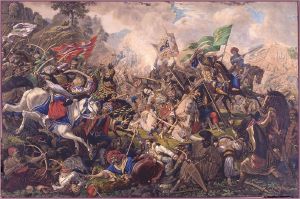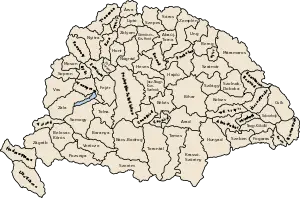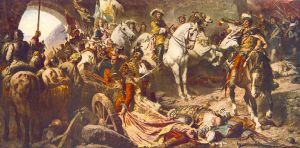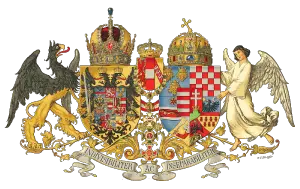Kingdom of Hungary
| |||||||||||||||||||||||||||||
The Kingdom of Hungary (short form: Hungary), which existed from 1000 to 1918, and then from 1919 to 1946, was a considerable state in Central Europe.
Names
In the late middle ages, the Latin terms "Natio Hungarica" and "Hungarus" referred to all of the population, as loyalty and patriotism towards the crown existed among all inhabitants, regardless of ethnic origins. However, according to István Werbőczy's Tripartitum, the "Natio Hungarica" referred only to the privileged noblemen (regardless of ethnicity), as subjects of the Holy Crown of Hungary
The Latin Regnum Hungariae/Vngarie (Regnum meaning kingdom); Regnum Marianum (Kingdom of St. Mary); or simply Hungaria was the form used in official documents from the beginning of the kingdom to the 1840s.
The German name (Königreich Ungarn) was used from 1849 to the 1860s, and the Hungarian name (Magyar Királyság) was used in the 1840s, and again from the 1860s to 1918. The names in other languages of the kingdom were: Polish: Królestwo Węgier, Romanian: Regatul Ungariei, Croatian: Kraljevina Ugarska, Slovenian: Kraljevina Ogrska, Template:Lang-cz, Slovak: Uhorské kráľovstvo.
History
The territories of medieval Hungary were second to the Holy Roman Empire and its population was the third largest in Europe.
The Kingdom of Hungary consisted of present-day Hungary, Slovakia, Transylvania (in present-day Romania), Carpatho-Ruthenia (in present-day Ukraine), Vojvodina (in present-day Serbia), Burgenland (in present-day Austria), the Kingdom of Slavonia (part of Croatia), and other smaller territories surrounding present-day Hungary's borders.
The Croatia (without Slavonia), had autonomy between 1091 and 1868 within, and then between 1868-1918 in personal union with Hungary.

The Árpád dynasty
The first kings of the Kingdom were from the Árpád dynasty and the first Christian King was Stephen I of Hungary who was canonized as a Catholic saint. He fought against Koppány and in 998, with Bavarian help, defeated him near Veszprém.
The Roman Catholic Church received powerful support from Stephen I, who with Christian Hungarians and German knights wanted a Christian kingdom established in Central Europe. It was he, who created the Hungarian heavy cavalry as an example for Western European powers.
After his death, a period of revolts and conflict for supremacy ensued between the royalty and the nobles. In 1051, armies of the Holy Roman Empire tried to conquer Hungary, but they were defeated at Vértes mountain. However they were beat more times, the second greatest battle was at Pozsony in 1052. Before 1052 Peter Orseolo who was supporter of the Holy Roman Empire was an outcasted king by Samuel Aba of Hungary who was a hated king by the folk, but actually he wasn't bad, his origin was Kabar.[1] [2]
The second greatest Hungarian king, also from the Árpád dynasty, was Ladislaus I of Hungary, who stabilized and strengthened the kingdom. He was also canonized as a saint. Under of his rule Hungarians successful fought against the Cumans and conquered Croatia in 1091. [3] [4] [5] [6] [7] [8] . After Ladislaus, the next famous king of the Árpád dynasty was Coloman of Hungary, who conquered Dalmatia. Under reign of Béla III of Hungary the Kingdom rose equal European state in the 12th. In 1222 Andrew II of Hungary issued the Golden bull which laid down the principles of law.
Mongol invasion
In 1241, Hungary was invaded by the Mongols and while the first minor battles ended in Hungarian victories, the Mongols finally destroyed the Hungarian army at the Battle of Mohi.
The Mongols attacked Hungary with three armies. One of them attacked through Poland in order to withhold possible Polish auxiliaries and defeated the army of Duke Henry II the Pious of Silesia at the Legnica. A southern army attacked Transylvania, defeated the voivod and crushed the Transylvanian Hungarian army. The main army led by Khan Batu and Subutai attacked Hungary through the fortified Verecke Pass and annihilated the army led by the count Palatine on March 12, 1241.[9].
Despite the appearance of the Mongol invasion having been a surprise attack, the Hungarians had known, from various sources, that the Mongols were coming. Notable heralds of the oncoming invasion include the Friar Julian group, which warned the king about impending invasion it had established contact with Magna Hungaria and saw the aftermath of the destruction of both the Magna Hungaria and Volga Bulgaria earlier in the 13th century.
In 1242, after the end of the Mongol invasion, numerous fortresses to defend against future invasion were erected by Béla IV of Hungary. In gratitude, the Hungarians acclaimed him as the "Second Founder of the Homeland", and the Hungarian Kingdom again became a considerable force in Europe. In 1260 Béla IV lost the War of Babenberg Succession, his army was defeated at Battle of Kressenbrunn by the united Czech troops, however after in 1278, Ladislaus IV of Hungary and Austrian troops fully destroyed the Czech army at Battle on the Marchfeld.
In 1301, with the death of Andrew III of Hungary, the Árpád dynasty died out. The dynasty was replaced by the Angevins, followed by the Jagiellonians, and then by several non-dynastic rulers, notably Sigismund, Holy Roman Emperor and Matthias Corvinus.
The first Angevin king was Charles I of Hungary, who implemented considerable economic reforms, and defeated the remaining opposition to royal rule by the nobility, led by Matthew Csák. Louis I the Great succeeded him. Louis I met with success on the battlefield when he defended the Hungarian Kingdom from new attacks by lesser Mongol forces in the latter half of the 14th century.
The Hunyadi family
The Hungarian kingdom's golden age was during the reign of Matthias Corvinus, the son of John Hunyadi. His nickname was "Matthias the Just", but it is only legend. He further improved the Hungarian economy and practiced astute diplomacy in place of military action whenever possible. Matthias did undertake campaigning when necessary. In 1485, aiming to limit the influence and meddling of the Holy Roman Empire in Hungary's affairs, he occupied Vienna for 5 years. After his death, Vladislaus II of Hungary of the Jagiellonians was placed on the Hungarian throne.
At the time of initial Ottoman encroachment, the Hungarians successfully resisted conquest. John Hunyadi was leader of the Long campaign where the Hungarians tried to expel the Turks from the Balkan, early time it was successful, but finally they had to withdraw. In 1456, John Hunyadi, the father of Matthias Corvinus, delivered a crushing defeat on the Ottomans at the Siege of Nándorfehérvár. The Noon bell remembers about the fallen Christian warriors. In the 15th century, the Black Army of Hungary was a formidable modern mercenary army, with the most skilled troops of the Hungarian cavalry were the hussars. In 1479, under the leadership of Pál Kinizsi, the Hungarian army destroyed the Ottoman and Wallachian troops at the Battle of Breadfield. Army of Hungary, almost all times destroyed the enemies when Matthias was the king.
In 1526, at the Battle of Mohács, the forces of the Ottoman Empire annihilated the Hungarian army and in trying to escape, Louis II of Hungary drowned in the Csele Creek. Leader of the Hungarian army Pál Tomori also died in the battle.
Ottoman occupation
Due to Ottoman pressure, central authority collapsed and a struggle for power broke out The majority of Hungary's ruling elite elected John Zápolya (10 November 1526). A small minority of aristocrats sided with Ferdinand I, Holy Roman Emperor, who was Archduke of Austria, and was related to Louis by marriage. Due to previous agreements that the Habsburgs would take the Hungarian throne if Louis died without heirs, Ferdinand was elected king by a rump diet in December 1526.
On 29 February 1528, King John I of Hungary received the support of the Ottoman Sultan. A three-sided conflict ensued as Ferdinand moved to assert his rule over as much of the Hungarian kingdom as he could. By 1529 the kingdom had been split into two parts: Habsburg Hungary and "eastern-Kingdom of Hungary". At this time there were no Ottomans on Hungarian territories, except Srem's important castles. In 1532, Nikola Jurišic defended Kőszeg and stopped a powerful Ottoman army. By 1541, the fall of Buda marked a further division of Hungary to three areas. Even with a decisive 1552 victory over the Ottomans at the Siege of Eger, which raised the hopes of the Hungarians, the country remained divided until the end of the 17th century. The heroes live more in a famous poet, what was wrote by Sebestyén Tinódi Lantos called: Summáját írom Eger várának, I am writing history of Eger's castle"
Although the borders shifted frequently during this period, the three parts can be identified, more or less, as follows:
- Royal Hungary, which consisted of territories adjacent to the Hapsburgs' Austrian holdings. These were present day Slovakia, north-western Transdanubia, Burgenland, western Croatia, some non-contiguous territories (counties), and this defined the continuity of the Kingdom of Hungary. Though nominally this remained a separate state, it was administered as part of the Habsburgs' Austrian holdings and thus effectively became under Habsburg rule.
- The Great Alföld (i.e. most of present-day Hungary, incl. south-eastern Transdanubia and the Banat), partly without north-eastern present-day Hungary, became part of the Ottoman Empire (see Ottoman Hungary).
- The remaining territory became the newly independent principality of Transylvania, under Zápolya's family. Transylvania was a vassal state of the Ottoman Empire. In 1644 was the Winter Campaign when Miklós Zrínyi burnt the crucial Bridge of Eszék what was a Turkish supply line in Hungary.
At Battle of Saint Gotthard (1664) Austrians and Hungarians defeated the Turkish army. After a failed Ottoman invasion of Austria in 1683, the Habsburgs went on the offensive against the Turks and by the end of the 17th century, they managed to conquer the remainder of the historical Kingdom of Hungary and the principality of Transylvania. For awhile in 1686, Buda the capital again became free with European help.
Habsburg dominance
After the departure of the Ottomans, the Austrians dominated the Hungarian Kingdom. The Hungarians' renewed desire for an independent Hungary brought about Rákóczi's War for Independence. The most important reasons of the war were the: new and higher taxes, started again the Protestant pursuit, and portion. Rákóczi was a Hungarian noble, son of Ilona Zrínyi the legendary heroine and also a Ruler of Transylvania. He spent part of his youth in Austrian captivity. Troops of Rákóczi were the Kurucs. Initially, the Kuruc army attained several important victories due to their superior skilled light cavalry. Their weapons were mostly pistols, light sabre and fokos. At the Battle of Saint Gotthard (1705), János Bottyán decisively defeated the Austrian army. The famous Hungarian colonel Ádám Balogh, nearly captured in a battle Joseph I, the Emperor of Austria. In 1708, the Habsburgs finally defeated the main Hungarian army at Battle of Trencin, and this diminished the further effectiveness of the Kuruc army. While the Hungarians exhausted in the fights, the Austrians defeated the French army in the War of the Spanish Succession and could send more and more troops to Hungary against the rebels from West.
The next ruler of Hungary was the Austrian Emperor Charles VI, who settled numerous Vlach ethnic groups in Transylvania. From this time on, the designation Royal Hungary was abandoned, and the area was once again referred to as the Kingdom of Hungary. Throughout the 18th century, the Kingdom of Hungary had its own Diet (parliament) and constitution, but the members of the Governor's Council (Helytartótanács, the office of the palatine) were appointed by the Habsburg monarch, and the superior economic institution, the Hungarian Chamber, was directly subordinated to the Court Chamber in Vienna. The Hungarian Language reform started under reign of Joseph II. The reform age of Hungary was started by István Széchenyi a Hungarian noble, who built the one of the greatest bridge of Hungary the Széchenyi Chain Bridge.
The official language of the Kingdom of Hungary remained Latin until 1844. Then, between 1844 and 1849, and from 1867, Hungarian became the official language.
The European revolutions of 1848 swept Hungary as well. The Hungarian Revolution of 1848 sought to redress the long suppressed desire for political change, namely independence. The Hungarian National Guard was created by young Hungarian patriots in 1848. In literature, this was best expressed by the greatest poet of the Revolution, Sándor Petőfi. One of the most famous battles was in 1848 September 29, at the Battle of Pákozd. When Serbs attacked the Hungarians on South, a great general called Ernő Kiss stopped a three Serbian regiments only with 72 hussars it was in 1848.
As war broke out with Austria, Hungarian military successes, which included the brilliant campaigns of the great Hungarian general, Artúr Görgey, forced the Austrians on the defensive. Fearing defeat, the Austrians pleaded for Russian help, which, combined with Austrian forces, quelled the revolution. The desired political changes of 1848 were again suppressed until Austro-Hungarian Compromise of 1867.
Austria-Hungary
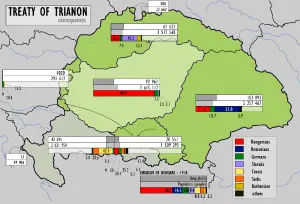
Following the Austro-Hungarian Compromise of 1867, the Habsburg Empire became the "dual monarchy" of Austria-Hungary.
The Austro-Hungarian economy changed dramatically during the existence of the Dual Monarchy. Technological change accelerated industrialization and urbanization. The capitalist way of production spread throughout the Empire during its fifty-year existence and obsolete medieval institutions continued to disappear. By the early 20th century, most of the Empire began to experience rapid economic growth. The GNP per capita grew roughly 1.45% per year from 1870 to 1913. That level of growth compared very favorably to that of other European nations such as Britain (1.00%), France (1.06%), and Germany (1.51%).
The historic lands of the Hungarian Crown (the Kingdom of Hungary proper, to which Transylvania was soon incorporated, and Croatia-Slavonia, which maintained a distinct identity and a certain internal autonomy), was granted equal status with the rest of the Habsburg monarchy. Each of the two states comprising Austria-Hungary exercised considerable independence, with certain institutions, notably the reigning house, defense, foreign affairs, and finances for common expenditures, remained under joint management. This arrangement lasted until 1918, when the Central Powers went down in defeat in World War I.
The new borders set in 1920 by the Treaty of Trianon, ceded 72% of the historically Hungarian territory of the Kingdom of Hungary to the neighbouring states. The beneficiaries were Romania, and the newly formed states of Czechoslovakia, and the Kingdom of Serbs, Croats and Slovenes. This left more than 3,5 million ethnic Hungarians outside the new borders, contrary to the terms laid out by US President Woodrow Wilson's Fourteen Points, which meant to honour the ethnic makeup of the territories.
Kingdom of Hungary between 1920-1944
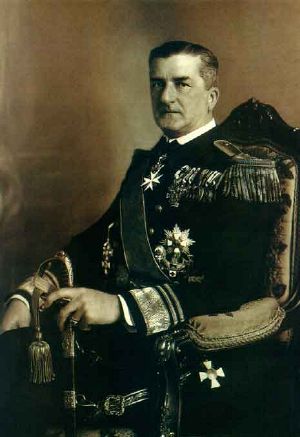
After the pullout of occupation forces of Romania in 1920 the country went into civil conflict, with Hungarian anti-communists and monarchists purging the nation of communists, leftists and others they felt threatened by. Later in 1920, a coalition of right-wing political forces united, and reinstated Hungary's status as a constitutional monarchy. Selection of the new King was delayed due to civil infighting, and a regent was appointed to represent the monarchy. Former Austro-Hungarian navy admiral Miklós Horthy became that regent.
The Kingdom of Hungary, which existed from 1920 to 1944, was a de facto regency under Regent Miklós Horthy, who officially represented the abdicated Hungarian monarchy. Attempts, by Charles IV King of Hungary, to return to the throne, were prevented by threats of war from neighbouring countries, and by lack of support from Horthy (see Charles IV of Hungary's conflict with Miklós Horthy).
The first ten years of this reinstated kingdom saw increased repression of the Hungarian minorities. Limits on the number of Jews permitted to go to university were placed[10], and corporal punishment was legalized. Under the leadership of Prime Minister István Bethlen, democracy dissipated as Bethlen manipulated elections in rural areas which allowed his political party, the Party of Unity to win elections repeatedly. Bethlen pushed for the revision of the Treaty of Trianon, but after the collapse of the Hungarian economy between 1929 to 1931, the national uproar pushed Bethlen to resign.
This state was conceived of as a "kingdom without a king", since there was no consensus on either who should take the throne of Hungary, or what form of government should replace the monarchy. The Kingdom of Hungary was one of the Axis powers during World War II until its attempted defection in 1944. This resulted on being occupied and dissolved by Nazi Germany, and replaced by a briefly-existing puppet state.
Historical perceptions
|
In today's Hungary, the Kingdom of Hungary is regarded as one long stage in the development of the state. This sense of continuity is reflected in the republic's national symbols, holidays, official language, and the capital city of the country and the short form of the country's name in Hungarian is (Magyarország) the same. The millennium of the Hungarian statehood was commemorated in 2000, and codified by the Millennium Act of 2000.[11]
In contrast, scholars outside Hungary observe that the Kingdom of Hungary, being a multiethnic and later multinational state, "bore little resemblance, in territory or population, to today’s Hungary".[12] This observation is reflected also by the fact that the Croatian, Serbian, Slovak and Slovenian languages (groups formerly within Hungary) have different names for the Kingdom of Hungary and modern Hungary.
Notes
- ↑ http://www.csongrad-megye.hu/turizmus/szoborpark/03.htm
- ↑ http://www.sulinet.hu/oroksegtar/data/100_falu/Feldebro/pages/003_aba.htm
- ↑ Croatia Britannica elementary article.
- ↑ Croatia UK EU Presidency 2005.
- ↑ Marko Marelic : The Byzantine and Slavic worlds.
- ↑ Hungary in American History Textbooks.
- ↑ Hungary, facts and history in breef.
- ↑ The language of Bulgarian and Croatian property purchases.
- ↑ Saunders, J. J. (1971). The History of the Mongol Conquests, Routledge & Kegan Paul Ltd. ISBN 0-8122-1766-7
- ↑ Numerus clausus
- ↑ Text of the Millennium Act (Hungarian)
- ↑ Brubaker, Rogers and Margit Feischmidt (2002). 1848 in 1998: The Politics of Commemoration in Hungary, Romania, and Slovakia. Comparative Studies in Society and History 44: 700–744.
ReferencesISBN links support NWE through referral fees
- Engel, Pál. 2001. The realm of St. Stephen: a history of medieval Hungary, 895-1526. London: I.B. Tauris. ISBN 9781860640612.
- Kontler, László. 2002. A history of Hungary: millennium in Central Europe. Houndmills, Basingstoke, Hampshire: Palgrave Macmillan. ISBN 9781403903167.
- Molnár, Miklós. 2001. A concise history of Hungary. Cambridge concise histories. Cambridge, U.K.: Cambridge University Press. ISBN 9780521661423.
- Saunders, J. J. 1971. The history of the Mongol conquests. New York: Barnes & Noble. ISBN 9780389044512.
- Sugar, Peter F., Péter Hanák, and Tibor Frank. 1990. A History of Hungary. Bloomington: Indiana University Press. ISBN 9780253355782.
See Also
External links
Credits
New World Encyclopedia writers and editors rewrote and completed the Wikipedia article in accordance with New World Encyclopedia standards. This article abides by terms of the Creative Commons CC-by-sa 3.0 License (CC-by-sa), which may be used and disseminated with proper attribution. Credit is due under the terms of this license that can reference both the New World Encyclopedia contributors and the selfless volunteer contributors of the Wikimedia Foundation. To cite this article click here for a list of acceptable citing formats.The history of earlier contributions by wikipedians is accessible to researchers here:
The history of this article since it was imported to New World Encyclopedia:
Note: Some restrictions may apply to use of individual images which are separately licensed.


